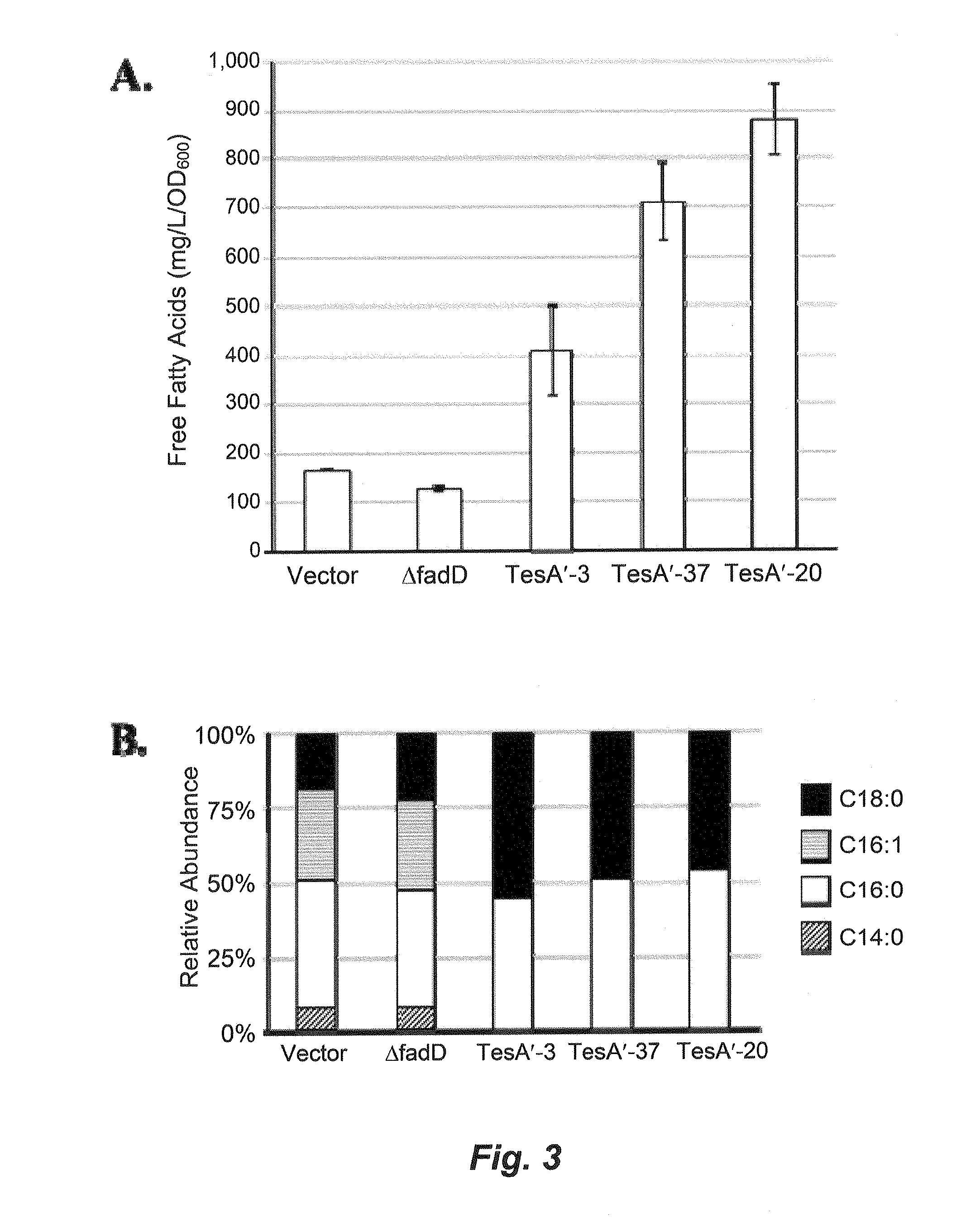Biorefinery system, methods and compositions thereof
a biorefinery and microorganism technology, applied in the direction of ligases, bulk chemical production, transferases, etc., can solve the problems of high production cost, insufficient farm land available, and insufficient supply of biofuels to date to meet both global food and fuel needs, etc., to achieve the effect of reducing or eliminating the activity of fatty acid-coa ligas
- Summary
- Abstract
- Description
- Claims
- Application Information
AI Technical Summary
Benefits of technology
Problems solved by technology
Method used
Image
Examples
example 1
Culture and Bioreactor Conditions for Lipid Production by C1 Metabolizing Microorganisms
[0139]Exemplary C1 metabolizing microorganisms of the instant disclosure (methanotrophs, methylotrophs, clostridia) were cultured in tubes, in vials, in bottles, on plates, or in a bioreactor (fermentation). Growth conditions, media, and carbon source for various microorganisms are described in this example.
Methylosinus trichosporium Strain OB3b (NCIMB 11131); Methylomonas sp. Strain 16a (ATCC PTA-2402); or Methylomonas methanica
[0140]For serum bottles, the bacteria were cultured at 30° C. in Higgins minimal nitrate salts medium (NSM; Cornish et al., J. Gen. Microbiol. 130:2565, 1984; Park et al., Biotechnol. Bioeng. 38:423, 1991) or MM-W1 medium. The headspace composition was adjusted to a 1:1 volume of methane:air. The bottles were shaken at a rate of 200-250 rpm. Alternatively, the culture was maintained on NSM-media plates containing 1.5% w / v agar grown in a gas-tight chamber containing a 1:...
example 2
C1 Metabolizing Microorganisms Engineered for Enhanced Lipid Production
[0172]Host cells were engineered to possess genetic modifications to minimize or reduce the degradation of fatty acids—by knocking-out long-chain fatty acid-CoA ligase activity encoded by the endogenous fadD gene. Furthermore, biosynthesis of free fatty acids (FFAs) was enhanced by introducing a thioesterase (TE) gene into a methanotroph of this disclosure (Methylococcus capsulatus). Such recombinant alterations are further described in this example.
Recombinant Nucleic Acid Molecules
[0173]The nucleic acid sequences encoding wild-type FadD proteins were the reference standard starting point for designing mutant fadD genes. For example, the wild-type FadD protein sequence encoded by M. trichosporium OB3b, M. capsulatus Bath, M. methanica, M. extorquens, and C. ljungdahlii are provided in GenBank Accession Nos. EFH00931.1, YP—114021.1, YP—004512148.1, YP—002964871.1, and YP—003782065.1, respectively. Hence, a nuclei...
example 3
Lipid Extraction from C1 Metabolizing Microorganisms
[0196]The oil composition contained within a harvested bacterial biomass was extracted using a modified version of Folch's extraction protocol (Folch et al., J. Biol. Chem. 226:497, 1957), performed at 20° C. (i.e., room temperature) and in an extraction solution made up of one volume methanol in two volumes chloroform (CM solution). About 5 g wet cell weight (WCW) of either fresh bacterial biomass (or bacterial biomass stored at −80° C. and subsequently thawed) was used for extractions. A 100 mL CM solution was added to the cell material and the mixture was extracted vigorously in a separatory funnel. After at least 10 minutes, three phases were resolved. The organic phase containing extracted lipids settled at the bottom of the separatory funnel, which was drained into a clean glass bottle. The middle layer contained primarily lysed cellular materials and could be separated from the light water phase containing salts and other so...
PUM
| Property | Measurement | Unit |
|---|---|---|
| octane number | aaaaa | aaaaa |
| v/v | aaaaa | aaaaa |
| Temperature | aaaaa | aaaaa |
Abstract
Description
Claims
Application Information
 Login to View More
Login to View More - R&D
- Intellectual Property
- Life Sciences
- Materials
- Tech Scout
- Unparalleled Data Quality
- Higher Quality Content
- 60% Fewer Hallucinations
Browse by: Latest US Patents, China's latest patents, Technical Efficacy Thesaurus, Application Domain, Technology Topic, Popular Technical Reports.
© 2025 PatSnap. All rights reserved.Legal|Privacy policy|Modern Slavery Act Transparency Statement|Sitemap|About US| Contact US: help@patsnap.com



